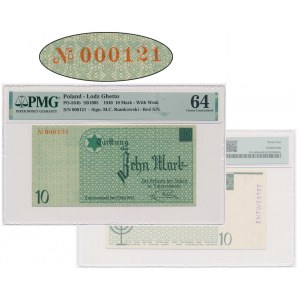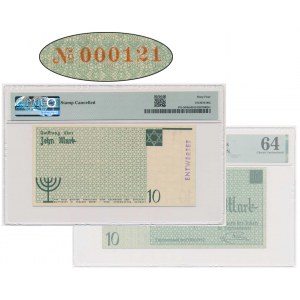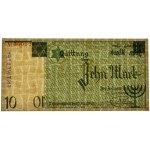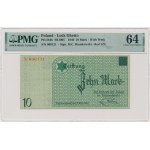A rare variant printed on watermarked paper. Type 1 numerator.
Very low number "000121" and ENTWERTET stamp (no value) on the reverse side.
Sets of Lodz ghetto voucher denominations stamped ENTWERTET were specially prepared in paper envelopes, and within the set all denominations were marked with an identical serial number. They probably constituted a form of souvenir set, which was intended for German officials.
A paperclip mark in the upper margin. Typical of all vouchers with the ENTWERTET stamp.
Banknote certified by PMG with a PMG grade of 64, which is the best possible grade for a banknote bearing a secondary stamp.An extremely rare Lodz Ghetto banknote, printed on watermarked paper and marked with a low serial number. Excellent state of preservation confirmed by a very good grade from PMG.
In September 1939, due to the aggression of Nazi Germany against Poland, the Bank of Poland with its Government and President evacuated outside the borders of the Second Republic. In view of the lack of cash reserves, deposits in the giro accounts of the Bank of Poland were frozen. As a result of this action, private banks and savings banks could not maintain solvency, and the population lost access to their cash deposits held in accounts.
The evacuation of the Bank caused a severe gap in the Polish economic apparatus. Consequently, as early as October 1939, the economic spheres began to demand the establishment of another issuing institution to take over the duties of the Bank of Poland.
When, in November 1939, the first talks took place between representatives of the Polish economic spheres and the occupation authorities on the establishment of a new issuing institution, Feliks Młynarski put forward the demand that the appearance of the graphic design of the new paper money should be similar to that of the interwar zlotys, and that there should be inscriptions only in Polish. Mlynarski also postulated that the name of the issuing institution should include the phrase "in Poland."
In countries occupied by Germany during World War II, the Germans established ghettos intended for the Jewish population. These were segregated and fenced-off parts of cities where the Jewish population was forcibly relocated. Among the Jewish quarters created on Polish soil, the Lodz Ghetto deserves special attention. It was one of the few such places that had its own currency. Money for the Lodz ghetto was used only for internal circulation. Possession of other currency was punishable by death. It was a way of obtaining German currency and foreign currency from ghetto residents. The money was issued by the Ghetto Bank. These were banknotes with poor graphic design limited to a simple ornamental drawing. Its purpose for the residents of the ghetto is evidenced by the two Stars of David placed on the obverse and the menorah incorporated on the reverse.












